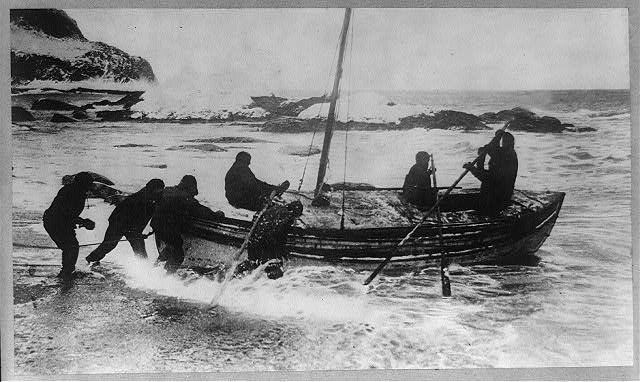When Shackleton’s Endurance was crushed by October ice in Antarctica, he and five companions set out for South Georgia Island, 800 miles away, in some of the most stormy and cold ocean on Earth. Their boat was a whaler, James Caird, barely big enough for the men and supplies. But it held, and enduring the open sea from April 24 –May 10, 1916, Shackleton and crew beached on South Georgia Island where they might dry out and bask in temperatures just above freezing.
The “sixteen days’ journey,” Shackleton writes, “is one of supreme strife amid heaving water,” ending with an elation that only comes after a near disaster and the threat of death. They dried out and feasted for five days and got busy again. The weather buoys Shackleton’s spirits: “May 15 was a great day. We made our hoosh at 7.30 a.m. Then we loaded up the boat and gave her a flying launch down the steep beach into the surf. Heavy rain had fallen in the night, and a gusty north-westerly wind was now blowing, with misty showers. The James Caird headed to the sea as if anxious to face the battle of the waves once more. We passed through the narrow mouth of the cove with the ugly rocks and waving kelp close on either side, turned to the east, and sailed merrily up the bay as the sun broke through the mists and made the tossing waters sparkle around us. We were a curious-looking party on that bright morning, but we were feeling happy. We even broke into song, and, but for our Robinson Crusoe appearance, a casual observer might have taken us for a picnic party sailing in a Norwegian fiord or one of the beautiful sounds of the west coast of New Zealand. The wind blew fresh and strong, and a small sea broke on the coast as we advanced.”
The menu for the journey included Fledgling Albatross Stew, Sea Elephant Steak and Liver, Biscuits, and Water.
Featured Image: Frank Hurley. Ernest Shackleton and Crew departing Elephant Island, April 24, 1916. Courtesy Library of Congress
See http://www.gutenberg.org/files/5199/5199-h/5199-h.htm

